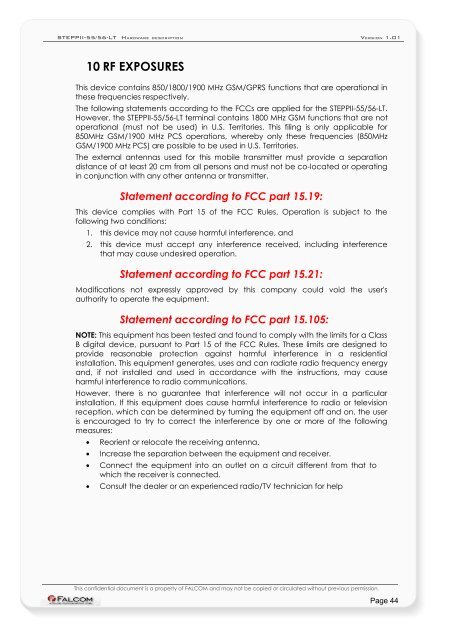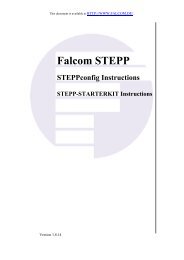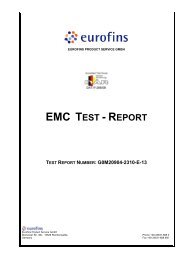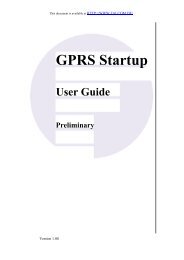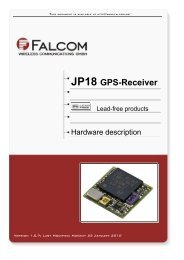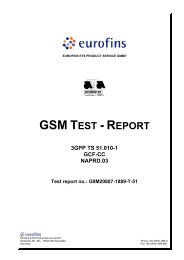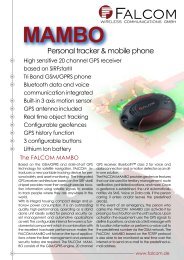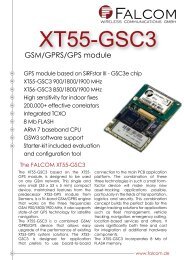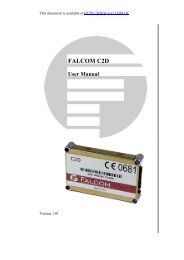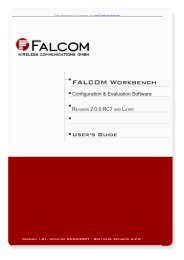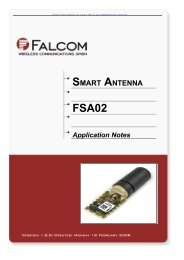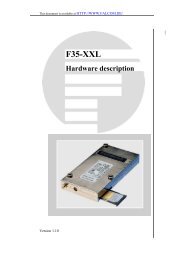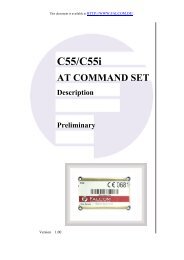steppii-55/56-lt - Falcom
steppii-55/56-lt - Falcom
steppii-55/56-lt - Falcom
You also want an ePaper? Increase the reach of your titles
YUMPU automatically turns print PDFs into web optimized ePapers that Google loves.
STEPPII-<strong>55</strong>/<strong>56</strong>-LT HARDWARE DESCRIPTION VERSION 1.01<br />
10 RF EXPOSURES<br />
This device contains 850/1800/1900 MHz GSM/GPRS functions that are operational in<br />
these frequencies respectively.<br />
The following statements according to the FCCs are applied for the STEPPII-<strong>55</strong>/<strong>56</strong>-LT.<br />
However, the STEPPII-<strong>55</strong>/<strong>56</strong>-LT terminal contains 1800 MHz GSM functions that are not<br />
operational (must not be used) in U.S. Territories. This filing is only applicable for<br />
850MHz GSM/1900 MHz PCS operations, whereby only these frequencies (850MHz<br />
GSM/1900 MHz PCS) are possible to be used in U.S. Territories.<br />
The external antennas used for this mobile transmitter must provide a separation<br />
distance of at least 20 cm from all persons and must not be co-located or operating<br />
in conjunction with any other antenna or transmitter.<br />
Statement according to FCC part 15.19:<br />
This device complies with Part 15 of the FCC Rules. Operation is subject to the<br />
following two conditions:<br />
1. this device may not cause harmful interference, and<br />
2. this device must accept any interference received, including interference<br />
that may cause undesired operation.<br />
Statement according to FCC part 15.21:<br />
Modifications not expressly approved by this company could void the user's<br />
authority to operate the equipment.<br />
Statement according to FCC part 15.105:<br />
NOTE: This equipment has been tested and found to comply with the limits for a Class<br />
B digital device, pursuant to Part 15 of the FCC Rules. These limits are designed to<br />
provide reasonable protection against harmful interference in a residential<br />
installation. This equipment generates, uses and can radiate radio frequency energy<br />
and, if not installed and used in accordance with the instructions, may cause<br />
harmful interference to radio communications.<br />
However, there is no guarantee that interference will not occur in a particular<br />
installation. If this equipment does cause harmful interference to radio or television<br />
reception, which can be determined by turning the equipment off and on, the user<br />
is encouraged to try to correct the interference by one or more of the following<br />
measures:<br />
• Reorient or relocate the receiving antenna.<br />
• Increase the separation between the equipment and receiver.<br />
• Connect the equipment into an outlet on a circuit different from that to<br />
which the receiver is connected.<br />
• Consu<strong>lt</strong> the dealer or an experienced radio/TV technician for help<br />
This confidential document is a property of FALCOM and may not be copied or circulated without previous permission.<br />
Page 44


